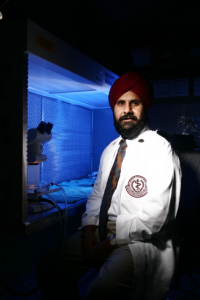By Shirlett Warren/nw news editor
Alzheimer’s disease is the sixth-leading cause of death in the U.S. with as many as 5.4 million Americans living with the disease, an expert on Alzheimer’s said.
 Meharvan Singh, chair of pharmacology and neuroscience at the University of North Texas Health Science Center in Fort Worth, spoke to more than 50 faculty members and continuing education students about the debilitating disease and the importance of detecting it early during a luncheon sponsored by the NW Wellness Committee, Support Staff and Professional Development Committee, Senior Education and Health Services.
Meharvan Singh, chair of pharmacology and neuroscience at the University of North Texas Health Science Center in Fort Worth, spoke to more than 50 faculty members and continuing education students about the debilitating disease and the importance of detecting it early during a luncheon sponsored by the NW Wellness Committee, Support Staff and Professional Development Committee, Senior Education and Health Services.
“By the time Alzheimer’s disease is diagnosed, the pathology may have been already ongoing for as many as 20 years,” he said.
Alzheimer’s is a brain disease that destroys brain cells and causes severe problems with thinking, behavior and memory. With the exception of rare cases of genetic inherited forms of the disease, the cause of Alzheimer’s is currently unknown, Singh said.
“What we have identified are two hallmarks of the Alzheimer’s brain: amyloid plaques and tangles,” he said.
He directed the audience’s attention to a tree outside. The way the branches formed are similar to healthy functioning neurons in the brain, he said. Amyloid plaques are thousands of protein molecules that clump between the brain’s nerve cells (tree branches), and tangles (deteriorating limbs) are twisted strands of another protein formed in brain cells, Singh said.
“The AD brain is functionally impaired. The challenge is diagnosing the disease,” he said. “If the cells are there but they’re just sick, we can rescue them. But if they’re gone, there’s nothing we can do.”
In the early stages, the disease starts in the brain’s frontal cortex and hippocampus. These sections of the brain generate thoughts, solve problems, make plans and also form and store memories, Singh said.
“One of the earliest symptoms of the disease is the loss of the sense of smell,” he said. “The olfactory bulbs, which control the sense of smell, are just under the frontal cortex.”
Other warning signs of the disease include disruptive memory changes, difficulty in planning and solving problems and time and place confusion.
“Just because we forget where we left our keys doesn’t mean we’re in the beginning stages of Alzheimer’s,” he said.
Mild cognitive impairment, when a person has noticeable mental function challenges and memory and language problems that don’t necessarily interfere with day-to-day activity, is a risk factor of Alzheimer’s that should not be ignored, Singh said.
Other risk factors include cardiovascular disease, diabetes and stroke. Head trauma also increases risk for the disease.
“A person with a moderate head injury is two times more likely to develop Alzheimer’s disease, and a severe head injury is four and one half times more likely,” he said.
The severity of a head injury is determined by the duration of unconsciousness. Anything less than 30 minutes is considered moderate, and anything longer is considered severe, he said.
Chelsea Moore, a NW health services administrative assistant, said her grandfather died from Alzheimer’s disease.
“I didn’t realize things like moderate head trauma increase the risk of the disease,” she said.
Kiki Robbirds, a NW graphics specialist, said her great-grandmother died of Alzheimer’s, and now her grandmother is starting to show symptoms.
“Her word recall is very bad, and conversations are difficult. She’s starting to believe that her neighbors are stealing things from her house. I validate her fears, but that’s simply not happening. She’s had the same neighbors for over 30 years,” Robbirds said. “I can’t convince her to go to a doctor.”
Singh said doctors can diagnose the disease through neurological testing, autopsy and brain imaging scans. While there is currently no known cure for Alzheimer’s, treatments now available can temporarily slow the progression of the disease and manage symptoms up to a point.
“In order to tackle this disease, we need more funding,” he said.
He showed a chart listing the mortality rates of the top 10 major diseases. Every disease but Alzheimer’s showed a decrease in death since the year 2000.
The mortality rate in Alzheimer’s increased by 66 percent between 2000 and 2008.
“About 90 percent or more of Alzheimer’s disease research applications are not getting funded,” he said. “Approximately 454,000 people developed the disease in 2010. If we don’t address the treatment of the disease today, the financial burden will bring our health care system to its knees.”
Singh said the National Institute of Health has an annual budget of $32 billion of which $480 million goes to Alzheimer’s research.
“In 2011, consumers spent $1.02 billion on snacks for the Super Bowl. That is double what is being spent on researching Alzheimer’s disease,” he said.
He said citizens can challenge local, state and federal representatives to increase funding for Alzheimer’s disease-related research and programs and can educate themselves and others.
“Learn the warning signs. Learn what resources are available to those who are affected by Alzheimer’s, both patients and loved ones,” he said.
For Singh, tackling Alzheimer’s isn’t just a passion, it’s personal.
“My goal is to put myself out of business,” he said. “I want my daughter to read about Alzheimer’s disease in history books, not taking care of me when I’m old.”

